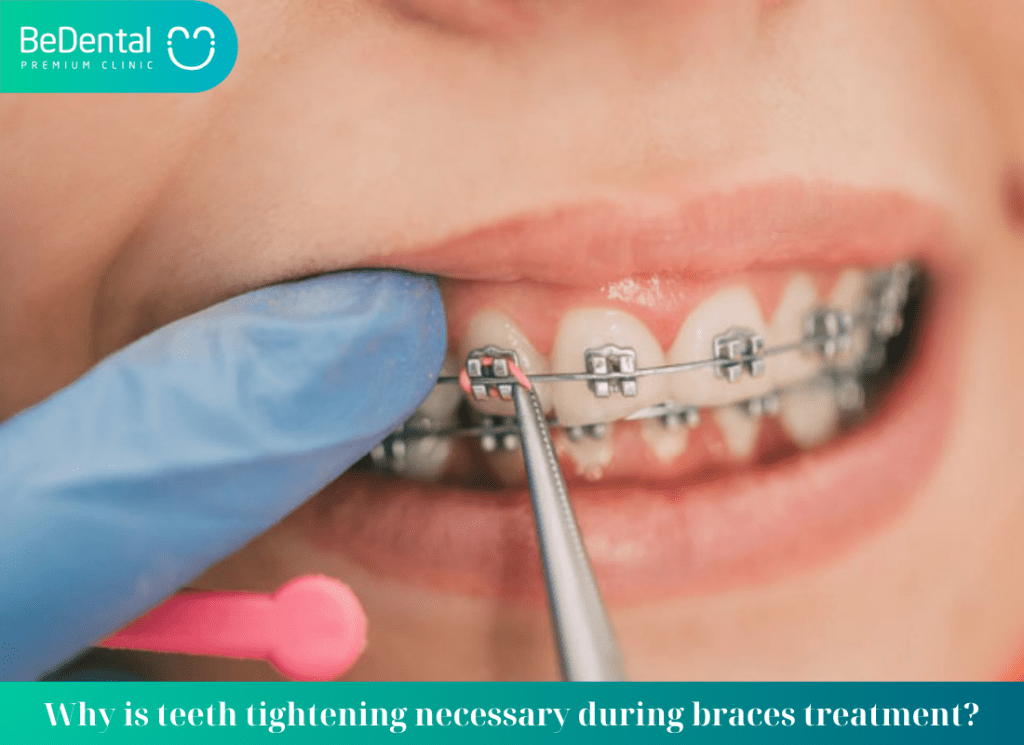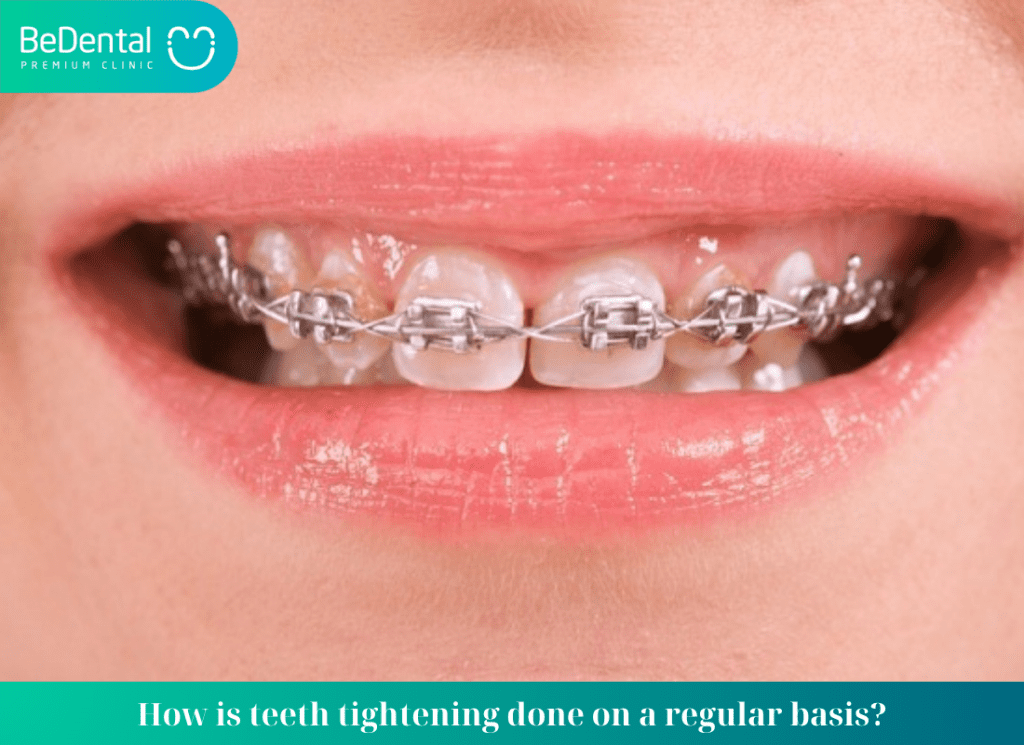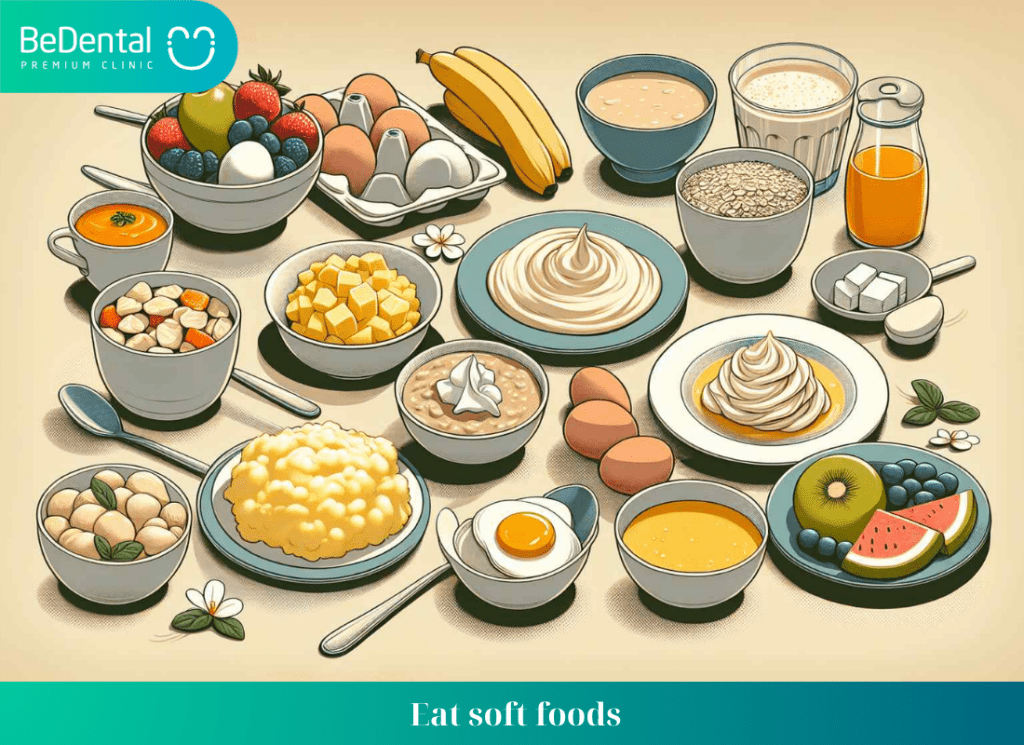What is different about teeth tightening during braces? We will share some effective tips to reduce pain when tightening braces in the article below, let’s find out!
Why is teeth tightening during braces treatment necessary? What is different about teeth tightening during braces?
The main purpose of braces treatment is to adjust misaligned or crooked teeth back to their correct positions on the dental arch, helping the teeth become more even and aligned. This teeth alignment process will require the use of teeth tightening method because teeth tightening allows the orthodontic wire to exert a stable force on the braces, thereby helping the teeth slowly move back to the correct positions on the dental arch.

Unlike other dental services that can be completed in one session, braces treatment requires a long process that can last from 12 to 36 months, as well as numerous teeth tightening sessions to allow the teeth to return to their correct and even positions.
Therefore, when undergoing braces treatment, it is important to strictly follow the scheduled appointments with the dentist. This enables the dentist to monitor and make adjustments to the wires according to the treatment plan in order for the braces treatment process to proceed smoothly, safely, and achieve optimal results.
How often should teeth tightening be done during braces treatment?
The frequency of teeth tightening during braces treatment can vary depending on the individual treatment plan and the specific needs of the patient. In general, teeth tightening sessions are typically scheduled every 4 to 6 weeks during braces treatment
To date, dentists have implemented various methods of braces treatment to meet the specific needs of each patient. Among them, braces treatment is divided into two main types: braces with brackets and clear aligners. For cases of braces treatment with clear aligners, the patient will use a specialized set of aligner trays, custom-made for each case and numbered to correspond to the changes in the forces applied to the teeth in different directions to help straighten and align the teeth.
The advantage of using aligner trays is that the patient can replace the trays at home according to the treatment plan provided by the dentist. Compared to braces treatment with brackets, which requires regular visits to the dental clinic for the dentist to adjust the brackets, individuals undergoing braces treatment with brackets, whether made of ceramic, metal, or crystal, must visit the dental clinic for the dentist to tighten the orthodontic wire for the teeth to be adjusted in each stage.
This is considered a crucial and mandatory step for individuals undergoing braces treatment as it is closely related and significantly impacts the outcome of the braces treatment.

Accordingly, dental experts have stated that the teeth tightening process can occur at regular intervals ranging from 3 to 6 weeks. At this time, the dentists will conduct examinations on the teeth to assess how the teeth are progressing in terms of movement and whether they are following the treatment plan correctly.
Additionally, the dentists will also perform tasks such as increasing the tightening force on the teeth, replacing elastic bands, or installing new orthodontic wires.
Furthermore, in order to expedite the braces treatment process, the regular teeth tightening schedule can be shortened to 1-2 weeks with increased tightening force. However, this is not recommended in braces treatment. This is because during this period, the bone has not had enough time to regenerate when pulling the teeth from one position to another.
How is teeth tightening done on a regular basis? What is different about teeth tightening during braces?
How is teeth tightening done on a regular basis? According to the schedule, after approximately 3-6 weeks, you will need to visit the dentist once for a check-up and teeth tightening. At this time, the dentist will conduct an overall examination of the teeth, and then tighten or adjust the brackets and orthodontic wires for the patient.

After the regular teeth tightening session, individuals wearing braces often experience pain and discomfort. In some cases, the archwire may poke against the cheek. If this happens, the person wearing braces should immediately notify the dentist to have it adjusted. Failure to do so may lead to damage to the cheek area over time.
Feeling pain and discomfort after teeth tightening is a common issue, however, it usually subsides within 3-5 days after the tightening session, and there is no need to worry excessively. The best approach is to learn about tips that can help alleviate the pain and discomfort in these situations, which can be done at home.
Some tips to reduce pain when wearing braces
Braces are an optimal method for aligning teeth, but during the tightening process, individuals may experience pain and discomfort that nobody desires. This is also a concern and fear for many people before and during the decision to get braces. Despite this, we still have solutions to help reduce pain and soothe this discomfort using methods such as:
See more: Tips for eliminating bad breath
Tip to reduce pain when wearing braces: Gently massage the gums
To achieve optimal occlusion, dentists will adjust the teeth to the appropriate positions during braces treatment so that the teeth gradually return to their correct positions and aesthetically harmonize the facial structure for the individual wearing braces.
This implies that the dentist will also use specialized tools to act on the teeth, perform tightening of the orthodontic wires, which inadvertently exerts pressure on the gum tissue, causing discomfort and pain for both the teeth and gums.
Therefore, massaging the gum area is a very effective way to soothe and alleviate discomfort in the painful areas and help the body of the person wearing braces adapt more easily to the orthodontic appliances.
At this point, when you feel pain and discomfort, use your fingers to gently massage the gum area in a clockwise direction, and then reverse the direction. This will significantly reduce the pain in that area.
Tip to reduce pain when wearing braces: Use pain relievers

One way to help reduce pain significantly after teeth tightening is to use pain relievers. Pain relievers can quickly reduce pain. Some types of pain relievers that can help in this situation include acetaminophen or ibuprofen.
However, before using any medication, you should consult with a doctor to ensure that you are using the correct medication, dosage, and administration to protect your health. You should also avoid excessive consumption as it may lead to complications from the side effects of the medication.
Tip to reduce pain when wearing braces: Apply heat
Warm water helps you relax and dilates blood vessels, which effectively reduces pain. You can use a warm towel to apply to the areas that are painful. Note that you should only use warm water to avoid burning your skin.
See more: Does smoking pods cause yellow teeth?
Tip to reduce pain when wearing braces: Apply cold compress
Applying a cold compress is an effective method to reduce pain not only on the body but also when tightening braces. You can use a clean cloth, place a few ice cubes, wrap it, and apply it to the areas where you feel numbness and discomfort.
The cold from the ice will immediately soothe the uncomfortable pain. You can do this multiple times a day or whenever you feel pain and discomfort.

Tip to reduce pain when wearing braces: Rinse with salt water
Salt water has excellent pain-relieving and antibacterial properties, helping to clean the mouth and reduce pain effectively. Therefore, using warm salt water to reduce pain after braces tightening is an extremely effective method. Simply add a small amount of salt to warm water, dissolve it, and rinse your mouth. Each rinse should last for 60 seconds. Additionally, warm salt water can help reduce inflammation, pain, and irritation in cases where brackets rub against the inner cheek causing damage.
Tip to reduce pain when wearing braces: Use orthodontic protective tools or dental wax
When wearing braces, brackets can be the cause of soft tissue damage in the mouth and inner cheek due to constant rubbing. Therefore, using dental wax can help protect the tissue from coming into contact with the brackets, thus preventing damage to these areas. This can somewhat reduce the pain and discomfort after the bracket tightening process during braces treatment.
See more: The 10 most common oral diseases
Furthermore, wearing braces is a sensitive time that requires the protected teeth to avoid strong external forces that can cause injuries to the teeth and orthodontic appliances, ensuring a safe braces treatment process.
Especially during the braces treatment, activities like physical exercise, sports cannot be avoided. Without proper protection, you are at risk of injuries or impacts to the braces area. Therefore, using protective tools is essential to help you avoid injuries or discomfort during braces treatment.
Tip to reduce pain when wearing braces: Eat soft foods

During the braces tightening process, it is inevitable to experience throbbing pain that affects the daily life activities of the person wearing braces as well as their ability to chew. Therefore, to make the chewing process easier and more convenient, individuals wearing braces should minimize the intake of hard and tough foods to reduce the potential pain that may occur after tightening braces. At this time, the teeth and gums are very sensitive and fragile, unable to meet the demand for chewing hard and tough foods.
See more: How much does filling a cavity cost?
Therefore, during this period, individuals wearing braces should only eat soft, easy-to-chew, and non-chewy foods such as soup, porridge, mashed foods, etc. These foods are easy to break down and do not exert pressure on the teeth while chewing, reducing the need for excessive chewing to avoid causing pain in the teeth. This can help the brackets stay in place better, reduce the most pain, and have a positive impact on the braces treatment process.
Through the article above, BeDental has helped answer the question “What is teeth tightening during braces? Some effective tips to reduce pain when tightening braces.” If you have any questions, please feel free to contact us for detailed answers! Tư vấn chuyên môn bài viết:
BÁC SĨ DƯƠNG THỊ THÙY NGA
Tại BeDental, khách hàng có thể an tâm điều trị với dịch vụ bảo lãnh viện phí nha khoa nhanh chóng và tiện lợi. BeDental hiện liên kết với nhiều công ty bảo hiểm uy tín, hỗ trợ thanh toán trực tiếp chi phí các dịch vụ nha khoa như nhổ răng, trám răng, điều trị tủy, phục hình răng sứ... Quy trình linh hoạt, minh bạch giúp tiết kiệm thời gian và tối ưu chi phí. Hãy liên hệ BeDental để được tư vấn chi tiết và tận hưởng trải nghiệm chăm sóc răng miệng chuyên nghiệp, không lo gánh nặng tài chính.
🔹 Các đơn vị nha khoa chấp nhận bảo lãnh bao gồm : Hùng Vương Insurance, Bảo Long Insurance, BSH (Bảo hiểm BSH), FWD Insurance Cathay Life Fubon Insurance, Tokio Marine Insurance Group VNI (Bảo hiểm Hàng không), HD Insurance MSIG AAA Insurance PTI (Bảo hiểm Bưu điện), BIDV MetLife, PJICO, Techcom, Insurance, AIA, Dai-ichi Life MIC GIC DBV Insurance VBI (Bảo hiểm VietinBank)
🔹 Các công ty bảo hiểm BeDental có thể xuất hóa đơn: Manulife Dai-ichi Life Prudential AIA Hanwha Life PVI VCLI (Bảo hiểm nhân thọ Vietcombank - Cardif) BIC (Bảo hiểm BIDV), Bảo Việt Insurance và PVI






